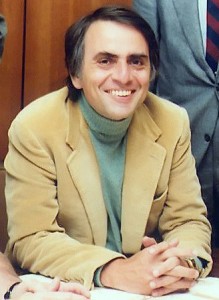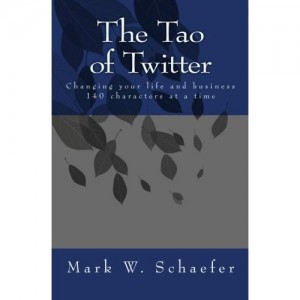Update #3 [Up at the top, so that hopefully people read it.] Does the title of this post make you angry? Well, you’re not alone. I continue to hear from many people who think I am downright stupid for daring to ask this question. Seeing all the backlash, I’ll be first to admit that I wish I had titled it something less provocative (even though it didn’t feel all that provocative at the time.) All I want to suggest is that we hold up some other examples of good science communicators, I don’t want to, or think that we can, erase the past. Sagan has a deity-like position for some people, and I didn’t do a very good job of explaining why that makes me feel so bad sometimes. I wanted to offer a different point of view. As was said to me on twitter, we should recognize Sagan the way we recognize Da Vinci, Einstein, Galileo – as greats. That doesn’t mean we should let that stall our ability to move forward and try to make new great things, with new great people.
Update #4 You know, the moment I had to ask my Mom (because my computer was giving me trouble and I couldn’t log into my own site – go figure) to log in to this site to respond to a comment to say that I don’t think Sagan hated women kind of made me want to give up completely. But I’ve read two thoughtful responses to my post, and I realized that the main thing I’m not saying is why I felt the need to write this in the first place. When we hold up Sagan again and again as the greatest there ever was, when we take his quotes and put them on pretty pictures that go viral, when the TV special continues to live online, when we talk again and again about how this one person inspired humanity and made people see that science is human – and all of it makes me feel nothing, I can’t help but think that perhaps I’m less than human. I joked with a friend yesterday that perhaps I’m just dead inside, but it isn’t really a joke to me. If Sagan represents all that is good, and I don’t understand it, then I can’t be good. So, if you want to know where this post was written, it was written from a place of fear and self doubt.
I am hopelessly optimistic about life to the point of near desperation to find the good in everything. So I thought, well, if I feel this way, other people must too. I warped that thinking into the blanket statements that caused so much of the trouble in this post. I know better than to publish without letting something sit so I can rethink it, and I broke my own rule, and made a mistake here. Some people have reached out to me to say they shared my feelings. So, to those people, I hope knowing you aren’t alone in not feeling so inspired makes you feel better.
My problem isn’t really with Sagan himself, and I didn’t do a good job of explaining that I take issue with the culture surrounding Sagan, with the way he is idolized as a one-and-only, with the vehemence of some of his fans. People have told me he would also promote women and diversity, which is a good thing. I do still think that other examples are needed not just to show a different approach to science communication, but to show different people to encourage other people that they can do this, even if they don’t see themselves in Sagan.
To everyone who challenged me to refine my thinking and more clearly state my point of view, you are everything I love about the Internet and I thank you for keeping your calm demeanor and engaging with me in a productive way. To everyone who called me stupid, self-absorbed, uneducated, and told me to learn my place, to learn some “respect, baby” well, I don’t particularly know what to say to you, but I hope you feel better too. To those who accused me of having no appreciation for the past, disrespecting my parents (what? – I felt so bad about that I even asked them, and they laughed at me) and wanting a world of nothing but listicles and Honey-Boo-Boo and instant gratification – that wasn’t the point I tried to make, which I admit to failing to make the first time, and I hope you’ll think again about what I’m actually asking us to do.
If what the world really needs are more and more Sagans, I guess I may be out of a job. But, I continue to think that I don’t really want to try to be anybody else, that’s the whole problem with idol worship, and I just want to try to make my own good things. Quite frankly, I don’t think we even CAN have another Sagan – it’s a very different world. I hope that in holding up other people as examples we can drive home the idea that there is more than one way to do something, more than one way to reach people, more than one way to do something good.
I also want to say that to those that called me out on categorizing Sagan based on his appearance, you’re right that I hate when it gets done to me, and as frustrating as I can get about it, it is still not right to categorize someone else that way. It wasn’t a productive way to have this conversation. If I offended you, but you kept quiet about it, you have my sincere apology too. The body of this post is largely intact, all of my flaws and all, so you can read the original below along with the other updates. I would also encourage you to read the response posts here and here.
It feels like I’m committing an act of science communication sacrilege here, but I have a confession to make: Carl Sagan means absolutely nothing to me. No more than any other person from my parents 1970’s yearbooks that could rock the turtle neck/blazer combo with the best of them. There, my secret is out.
[This paragraph is edited] I’m not saying I don’t like Sagan – I’m saying Sagan has zero influence on me or what I do. To me, Sagan is a stereotypical scientist who made some show that a lot of people really liked more than 30 years ago. That show – Cosmos: A Personal Voyage -was on air nearly a decade before I was even born. The reason I bring up my own age is because I’m as old, if not older, than the prime audience for science communication. I think anyone can learn to appreciate science at any age in life, but we stand the best chance at convincing people that science is something they can understand (and even do themselves) early in life when their beliefs are not so entrenched.
So then why, WHY as science communicators do we keep going around and around among ourselves about how Sagan – who is so far outside my life experience, let alone that of people younger than me – was the greatest science communicator of all time? We keep talking about who will (or won’t) be the next Carl Sagan but I promise you, no high school kid cares about Carl Sagan let alone whether or not science communicators think he was great. [Please see Updates #1 and #2 at the bottom of this post, to address the flaw in this blanket statement.] We spend so much time and energy talking about a guy that isn’t relevant anymore. The topics of space, the natural world, and how to communicate wonder are totally relevant to the public and to the science writing community. But, this one guy? Nope.
[This paragraph is edited] It isn’t just the age thing. I recently read Alone in a Room Full of Science Writers by Apoorva Mandavilli about the National Association of Science Writers annual meeting, and how there was a distinct lack of minorities, let alone minority women. She said:
“You can never overestimate how empowering it is to see someone who looks like you—only older and more successful. That, much more than well-meaning advice and encouragement, tells you that you can make it.”
That idea stuck with me. Role models are a great thing, and I get that Sagan inspired people to become scientists themselves. But, if we want to seriously address issues of diversity in science and science communication holding up the stereotypical scientist over and over again isn’t doing anyone any favors. I’m not trying to belittle anyone’s inspiration for pursuing science, let alone belittle Sagan himself. I respect the work Sagan did as a scientist and communicator. I respect that at the time he brought science into the mainstream in a way that hadn’t been done before. But, we need new things.
We need things that fit a modern era, things that will supplement the nerdy white dude stereotype (I mean, I generally like nerdy white dudes, you don’t have to leave, we just need other people too.) I believe that we can do better than lamenting some guy in a turtleneck as if nothing good will ever happen again. We can focus on diversity – showing men and women, of different ethnicities and backgrounds that science isn’t only for nerds.
The answer isn’t as simple as rebooting Cosmos, as FOX is doing, and sticking Neil deGrasse Tyson in front of the camera. While Tyson is far more relevant, and yes is a minority, we still need to get women, other minorities, and young people doing all kinds of science out in public view. If we want diversity we need to show people that people just like them can, and do, like science. We need everybody.
Now, I realize that instinctively we want to defend our childhood heroes. You may be sitting at your computer thinking, “but, but, you just don’t GET it, you don’t understand what a big impact Sagan had.” You are right, and that is 100% my point. I’m an admittedly nerdy, white, science communicator. If I don’t care about Sagan, do you honestly think the general public does? Science, particularly space, yes. Sagan, nope.
I sincerely hope the reboot of Cosmos starring Tyson does well, because science programming on a major television network in primetime is a good thing. I have faith that the science will be sound, and we are in dire need of an upgrade from Mermaids and Megalodons so I think it’s great. That said, I still think it is a complete waste of our efforts to keep going on and on about WHO will be the next Sagan when we should really be talking about HOW we’re going to engage with a diverse audience about science and WHAT platforms and tools will we use to be effective. To me, those are far more productive conversations to have.
The science isn’t going to stop being interesting, it isn’t going to stop being relevant – but if we can’t push our professional conversations and aspirations past Sagan, we will stop being relevant.
Bonus: I didn’t know where to include this link, but here is Hope Jahren’s Ode to Carl Sagan. You should probably read it.
Update: Well, this is easily the most talked about post I’ve ever written. Lots of feedback here and on twitter. Most prominent are the voices saying but I love Sagan, he did such good things. Rock on, I’m not saying that he didn’t. Keep your fondness for him. There are young people who find Sagan inspiring. Blanket statements like the ones I made here don’t do justice to the fact that really, what inspires you is deeply personal. To each, their own. I took a hard line stance because it feels important to me for people to feel comfortable admitting that Sagan doesn’t inspire them if he doesn’t. Again, to each their own. So, I nod to those young people who are inspired by Sagan, you’re right that I don’t speak for you, nor do I have a right to do so. But I also nod to everyone who said this made them feel better because other role models for science and science communication are something that many of us (if not all) would benefit from. Some people feel othered by not being into Sagan – if that makes any sense. But, I’m not trying to other anyone here either. I shouldn’t dismiss the significance of what Cosmos achieved, and should have included that we can still learn from what has been successful – even if I am seriously cautious about merely trying to replicate the past without pushing further, to do better.
Update #2: I wish I could change the title of this post to “Can We Stop Talking About Carl Sagan All of the Time” but it is what it is. I’m still getting comments about how wrong I am, because Sagan means so much to so many people, so to clarify: I took a very line in the sand approach in this post. I’ve talked to a lot of people since advocating for a middle of the road approach, the “we need everybody” that I mentioned. Keep Sagan, but find a way to promote others too. His popularity speaks to the fact that his work gets through to a lot of people. My blanket statements contradict that in a way that is confusing. I should have been more careful, and written about how he doesn’t get through to some people and we do need new things to get through to the people his work doesn’t reach. I don’t want us to throw away the good work that Sagan did and never talk about it ever again as if we can’t still get value from it. Keep what worked, appreciate the value added, but I still think shifting our focus to new things is beneficial.




